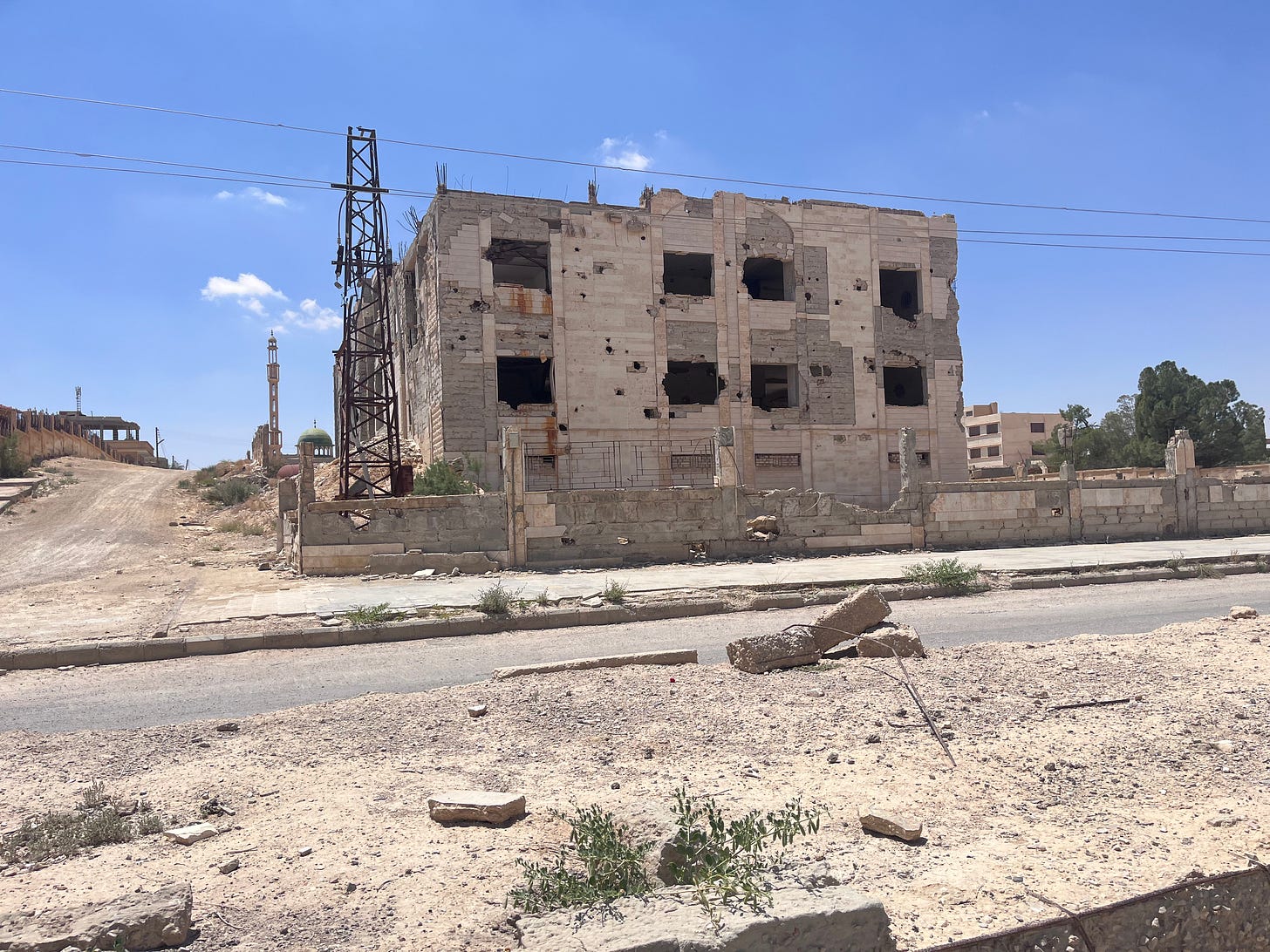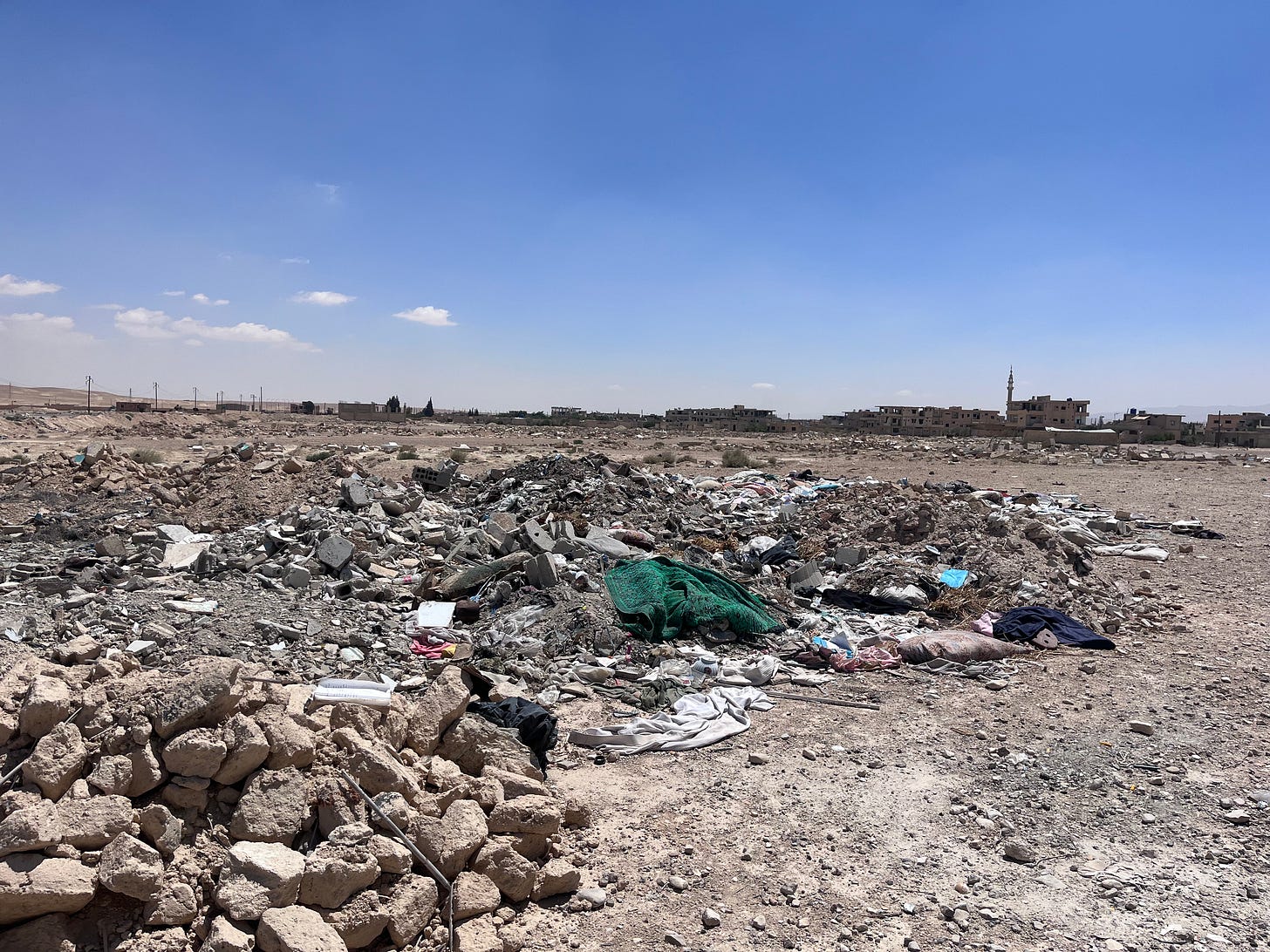On June 5, I traveled 2.5 hours into the Syrian desert to visit several remote villages which faced multiple waves of harm during the civil war, including by ISIS and the Assad regime. The objective of this visit was to spend the day with Syrian families who returned from the remote Rukban displacement camp to their homes in central Syria.
Today I visited the remote desert town of Qaryatain, which, for two years, was under ISIS control. ISIS left a brutal legacy on the town. They leveld homes, executed civilians in the street, destroyed an historic Aramaic church and its congregation, and damaged the town’s basic infrastructure, education, and livelihoods. In 2016, the Syrian regime and Russia launched a massive campaign to retake the area. The shelling was relentless, and much of the town was reduced to rubble. Even before regime forces entered the town, more than 100 civilians were executed by ISIS and hundreds of Christians kidnapped for ransom.
The following photo was taken after the Assad regime forced ISIS from Qaryatain in 2016:
This is my photo of roughly the same view of the village from June 2025:
Through all of this, people stayed. Even through the siege and bombardment, some families held on. And those who fled—many of whom were stranded and starving in the barren isolation of Rukban camp on the Syrian-Jordan border—have slowly begun returning. The numbers of returnees rose significantly after the fall of Assad on December 8th of last year. Since then, the road back has been hard but steady.
I visited a friend who was displaced from the village during the ISIS invasion and occupation in 2016. He and his family only returned in December 2024. He walked me through what occured. The market reopened. The cemetery which had been bulldozed flat by ISIS was being restored. Nearby, the outline of a trench—what he believes was a mass grave—dug by ISIS in an informal cemetary remains a scar on the land’s service (I also reported this to the appropriate authorities for documentation). His street is lined with homes bearing the scars of war: some pocked with bullet holes, others half-collapsed or reduced to rubble.
Outside the town, a large desert lake—once the main water source and teeming with fish—and miles of agricultural land were cut off from residents during intense periods of siege. This kept people from their land and livelihoods.
My friend also showed me what’s being rebuilt: some homes, power lines, and the local church, restored stone by stone.
The scars of war were everywhere. But amidst the pain, I witnessed a quiet, unexpected sense of joy—and even opportunity. Those I spoke with in the town expressed a cautious hope. They saw the recent suspension of sanctions as a positive step for Syria’s future, yet remained uncertain about what it would mean for their daily lives. One friend to me reflected on the hardship he now faces in the village and compared it to his time in Rukban, where he and his family—alongside thousands of others—endured prolonged starvation. For years, the Assad government blocked all goods from entering the camp, while the U.S. and Jordan did little to provide meaningful relief or pressure for access.
“Whenever I think of the little we have now, I am reminded of the nothing we had at Rukban. So we go day by day with our lives in the village. At least now I am confident I have tomorrow and with sanctions gone and Assad out, we have hope.” A Rukban resident who returned to Qaryatain
People here learned to laugh. I waved at them as they swept debris from their doorsteps. Children rode bikes through streets where shells once landed and bodies laid. For those who spent years starving in the desert—forgotten behind berms, blocked from aid—the ruins of this town feel like a second chance. There’s food. There’s movement. There’s community.
This visit was part of a longer story I am working on—tracing the stories of those I have known for nearly a decade who returned from the Rukban camp. What I saw today was not only the physical aftermath of ISIS and war, but also the quiet, determined beginnings of recovery. The town is still broken. But it’s breathing again. And that, in the remote desert town, is a kind of miracle.
They are clear eyed that the challenges ahead are massive. Since the fall of Assad’s control in this area, no major UN or NGO services have returned at scale. Government support or services are limited. The hospital is small and deeply under-resourced. Most of the town remains heavily damaged. There’s electricity from 6pm to 10pm each night—everything else runs on personal solar panels. Reconstruction will take years, maybe decades. And yet, people are already returning in droves. Towns like this cannot wait for the long-term yield of sanctions relief or diplomatic shifts to meet urgent needs like medical care and water. They need rubble removal, demining, and concrete. They also need human development: medical care and education, especially for returnees whose children have missed several years of school. In one case, I met a 14 year old who could neither read nor write because he was raised in a camp with education. These communities need support now.










